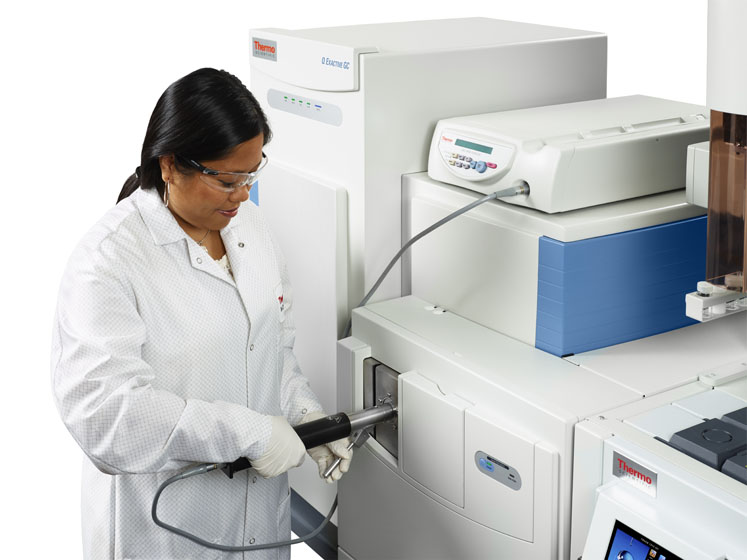In 2019, after independent laboratory testing revealed unacceptable levels of N-nitrosodimethylamine (NDMA) in some batches of the heartburn medication, ranitidine, the FDA announced its withdrawal from the market.1
Before this, in 2018, the presence of nitrosamine impurities also resulted in the recall of some angiotensin II receptor blockers (ARBs), a class of medicines collectively known as sartans that are used to treat high blood pressure and heart failure.2
Classified as a probable human carcinogen, the presence of nitrosamines in commercial drugs has emphasised the need for robust analytical methods to spot trace impurities and forestall any potential risks to consumers.
In response to the recent crisis, the FDA has published mandatory guidelines for nitrosamine testing. Using advanced technologies such as high-resolution accurate mass (HRAM) mass spectrometry, these FDA-approved methods will enable nitrosamine detection at even lower levels, ensuring that the drugs are safe for consumption.
Pharmaceutical companies are now required to comply with the new nitrosamine testing requirements. Nitrosamine impurities can stem from certain chemicals in raw materials, reaction conditions during the manufacturing process or from the active pharmaceutical ingredient (API) itself.
This means, rather than testing random batches, the entire manufacturing process will require nitrosamine testing. Merely verifying the good quality of raw materials will no longer suffice. Drug manufacturers will need to screen for, monitor and identify potential nitrosamine impurities before entering the market.
Here, we expand on the FDA-recommended analytical methods to detect and quantify nitrosamine impurities and offer key considerations for pharmaceutical companies to mitigate potential risks.
Nitrosamine impurities: what manufacturers need to know
Exposure to nitrosamines, commonly found at low levels in water and foods such as meat, dairy products and vegetables, is not atypical in our daily lives. However, the exposure to nitrosamines above acceptable levels for longer periods of time can increase the risk of cancer. To this effect, the FDA has established internationally recognised acceptable daily intake limits for nitrosamines.
The presence of unacceptable levels of nitrosamine impurities detected in ARB medicines in 2018 was unexpected.3 Ongoing efforts by the FDA and other international regulatory authorities have revealed multiple possible reasons for nitrosamines occurring in commercial drugs.
These impurities can originate from different sources related to the manufacturing process, including the quality of raw materials, chemical reaction conditions, the reuse of solvents and the chemical structure of the API. Additionally, several external factors, such as packaging or storage conditions, can intensify nitrosamine contamination.

Jon Bardsley
For example, in ranitidine, the FDA determined that nitrosamine impurities increased with time when stored in environments hotter than room temperature, resulting in potentially harmful nitrosamine levels.
Ultimately, pharmaceutical manufacturers are responsible for understanding their own processes, including the presence of unacceptable impurities in the drugs they manufacture. The FDA also considers it the manufacturer’s responsibility for developing and using analytical methods to detect and quantify impurities, such as nitrosamines, and for making suitable updates to the manufacturing process.
With multiple variables influencing the large-scale manufacturing of a drug, pharmaceutical companies will need to adopt modern, sensitive analytical techniques to meet the new FDA standards.
With an ongoing assessment of pharmaceutical quality, the FDA promptly acted on the nitrosamine issue in ARBs and ranitidine by publishing the following testing methods that can be used to detect and quantify nitrosamine impurities. These methods serve as a helpful example to manufacturers as they develop, optimise and validate methods to test for nitrosamines in their APIs or drug products.
Gas chromatography-mass spectrometry (GC-MS): This involves a combined GC-MS approach to simultaneously detect four nitrosamine impurities found in ARBs or sartan drugs, namely, NDMA, N-nitrosodiethylamine (NDEA), N nitrosodiisopropylamine (NDIPA) and N-nitrosoethylisopropylamine (NEIPA). The FDA developed and validated this method on valsartan.4
Liquid chromatography-high resolution mass spectrometry (LC-HRMS): The method used for nitrosamine analysis in ARBs was not suitable to test ranitidine as the thermal degradation caused by GC, in turn, resulted in the generation of nitrosamines. As a result, the FDA developed an alternative LC-HRMS method to measure nitrosamines in ranitidine with the limit of detection (LOD) set at 10 ng/g.5
Liquid chromatography-tandem mass spectrometry (LC-MS/MS): This LC-MS/MS method is based on the triple quadrupole MS platform that many laboratories currently have access to. It can be used as an alternative or confirmatory method for the above LC-HRMS approach.6
The increased knowledge in nitrosamine impurity subtypes, coupled with the advent of novel analytical technologies, enables more sensitive testing to accurately detect even trace amounts of impurities. By choosing the analytical method that’s most suitable for their drug, pharmaceutical manufacturers can reliably quantify nitrosamines to ensure that impurities never exceed acceptable limits.
Robust analytical methods to detect and quantify nitrosamines
As manufacturers gear up to include nitrosamine impurity testing into their workflows, one option to maintain quality and ensure compliance is to collaborate with contract organisations that offer tailored nitrosamine testing. For instance, Intertek, a good manufacturing practice (GMP)-compliant quality assurance contract organisation, helps pharmaceutical companies to meet FDA requirements by developing methods for risk evaluation and impurity testing.
Intertek has implemented the new FDA methods to assist pharmaceutical companies in performing method validations, impurity testing and toxicology risk assessments. The data produced from quality assured laboratories can support regulatory submissions or examine API quality standards before it enters the market.

Michael Walker
Whether pharmaceutical manufacturers outsource nitrosamine testing or perform the tests internally, choosing the most appropriate analytical technology is the first step towards reliable impurity detection. The FDA method used to detect six different nitrosamine impurities in ARBs utilises reverse phase chromatography for separation and HRAM mass spectrometry for detection.
Modern mass spectrometers, such as the Thermo Scientific Q Exactive Hybrid Quadrupole-Orbitrap Mass Spectrometer, offer high sensitivity to detect even low levels of analytes with confidence. With better than 1 ppm mass accuracy, the HRAM system yields accurate m/z values to detect nitrosamine impurity ions.
Detecting NDMA, a volatile liquid with low molecular mass, using LC-MS can result in ion interferences and noisy chromatograms. However, HRAM offers better selectivity as the higher resolution eliminates ion interferences without the need for tandem fragmentation, making it well suited for NDMA analysis.
Moreover, for every analysis, HRAM captures and stores all the data from a given sample. This allows retrospective examination of all ions, even beyond nitrosamines, in case APIs or drug products need to be further reviewed for unknown impurities. In the event of product recalls or updated FDA regulations, having HRAM data can enable quick reanalyses without having to repeat the testing process.
Modern Orbitrap mass spectrometers with full scan capabilities require minimal optimisation compared with traditional analytical methods. This flexibility is particularly useful when you need to act fast and perform the necessary testing to meet any FDA-imposed deadlines. Multiple analytes can be measured during a single run, enabling expanded risk assessment while saving time.
Advanced analytical systems are also compatible with a diverse range of APIs, formulations and drug products, making it possible for contract research organisations to do multiple projects on a single instrument.
The nitrosamine testing results provided by manufacturers also need to meet GMP quality standards. Built-in GMP compliance-ready features in systems such as Q Exactive Orbitrap eliminate potential gaps in data integrity. The electronic audit trail feature captures information about user history, protocols and instrument usage to demonstrate regulatory compliance to authorities.
Additionally, the GMP laboratories at Intertek also streamline workflows with compliance-ready software systems, such as the Thermo Scientific Chromeleon 7 Chromatography Data System (CDS). Equipped with audit tools integrated into the software, achieving and maintaining compliance is easier while optimising and validating methods for impurity testing.

To keep up with evolving standards, especially within the developing area of nitrosamine impurity, the analytical methods used by pharmaceutical companies need to be easily adaptable to change while maintaining regulatory requirements.
Liaising with contract organisations such as Intertek can enable manufacturers to not only obtain GMP-compliant data on impurity testing, but also perform the necessary risk assessment of their APIs.
How can manufacturers better prepare for FDA compliance
The FDA continually monitors unrecognised risks to uphold consumer safety. As all pharmaceutical manufacturers will need to comply with the recent FDA requirements on nitrosamine testing, we suggest a few steps to better prepare towards this change. Although a new requirement, a failure to comply with nitrosamine testing can result in product recalls, causing financial burden for the company and the disruption of medical care for loyal consumers.
As a starting step, manufacturers can assess potential risks involved in the manufacturing process. For example, recycled raw materials or reused solvents are at a higher risk of harbouring impurities. A detailed review of the manufacturing process can present opportunities for modification, especially for new or developing projects.
For existing products or those in the pipeline, performing a quick initial screen for impurities using low resolution tandem MS methods can accelerate the testing timeline. If impurities are detected during the screening process, manufacturers can then use highly sensitive analytical technologies to quantify any contamination and ensure that the impurity levels remain within acceptable FDA limits.
Above all, manufacturers will need to stay updated on developing FDA guidelines. As the investigation and testing on nitrosamine contamination continues, new findings may identify further impurity sources, subsequently informing decisions in the manufacturing process.
Conclusion
The presence of nitrosamines in commercially available drugs is a critical sign that we need to reassess the sensitivity of our analytical methods when detecting potentially harmful impurities … even at low levels. Recent product recalls for widely used drugs, such as ranitidine and ARBs, serve as a cautionary reminder to identify unknown risks and mitigate them before entering the market.
With a commitment to maintain patient safety, the pharmaceutical community will need to ensure nitrosamine levels in their API or drug products are well within acceptable FDA limits. By using analytical methods based on modern HRAM mass spectrometers, as recommended by the FDA, manufacturers can reliably obtain accurate and fast results to detect and quantify impurities to comply with the regulations.
References
- www.fda.gov/news-events/press-announcements/fda-requests-removal-all-ranitidine-products-zantac-market.
- www.fda.gov/news-events/press-announcements/fda-statement-fdas-ongoing-investigation-valsartan-impurities-and-recalls-and-update-fdas-current.
- www.fda.gov/drugs/drug-safety-and-availability/recalls-angiotensin-ii-receptor-blockers-arbs-including-valsartan-losartan-and-irbesartan.
- www.fda.gov/media/124025/download.
- www.fda.gov/media/130801/download.
- www.fda.gov/media/131868/download.
